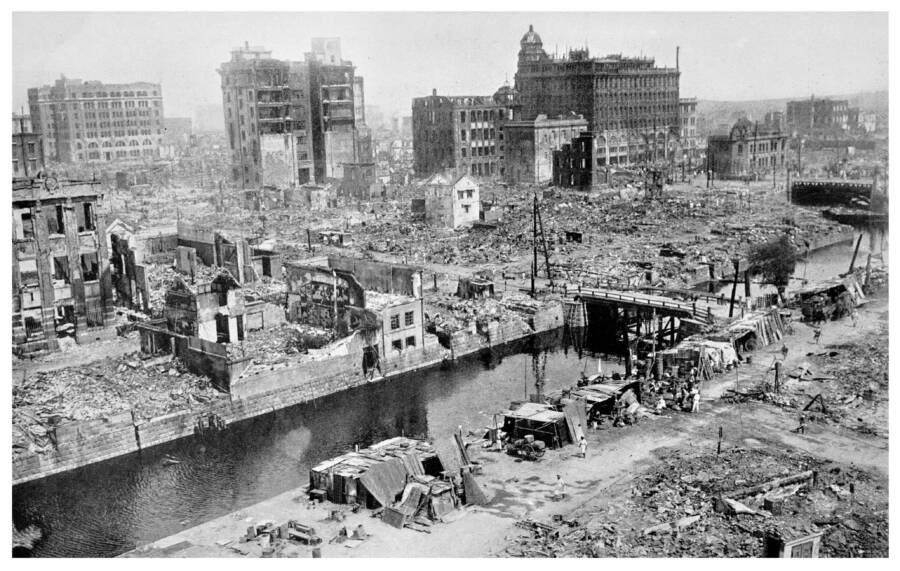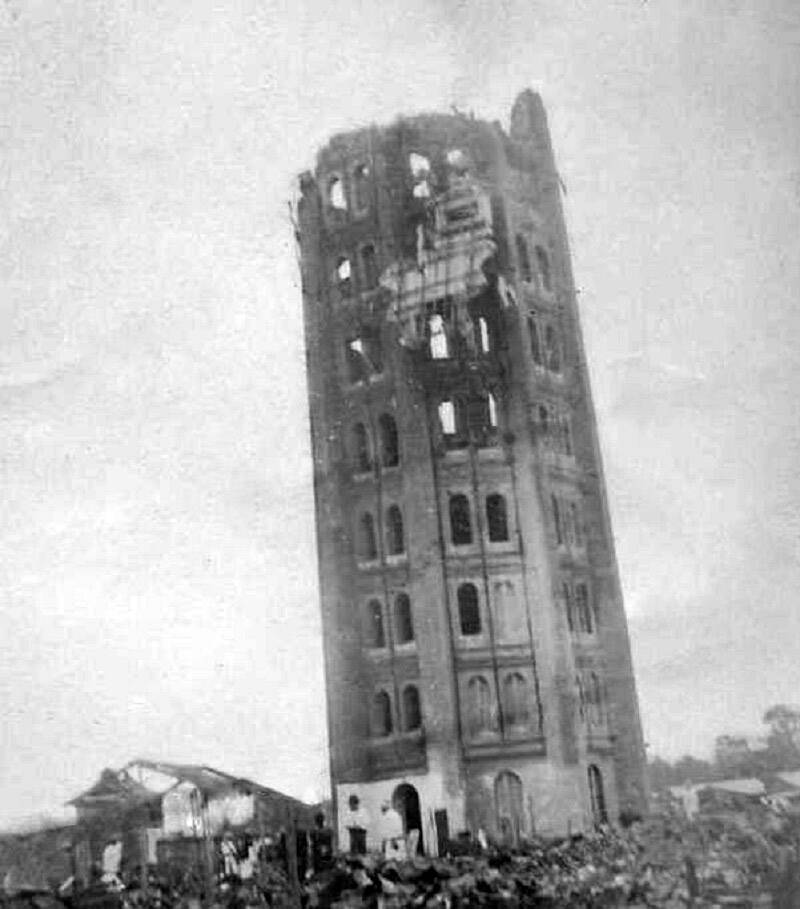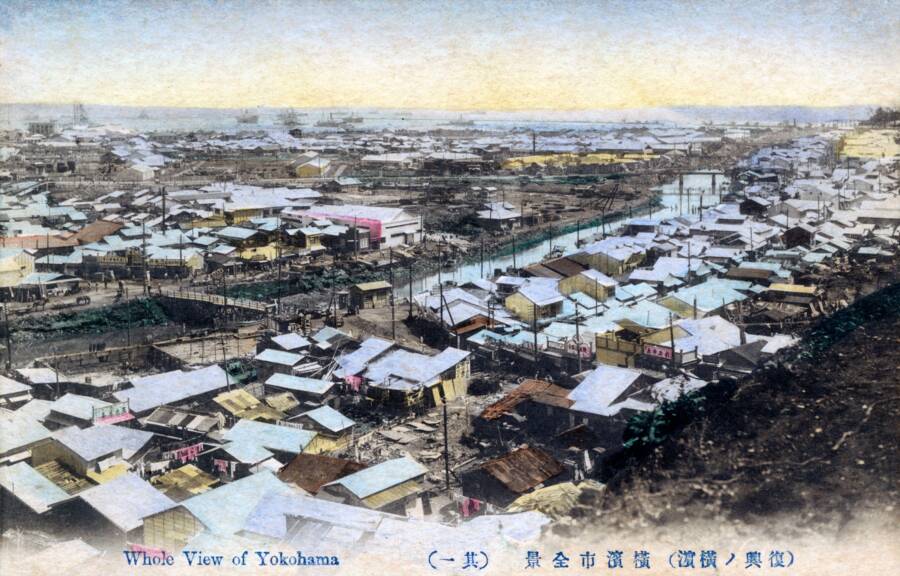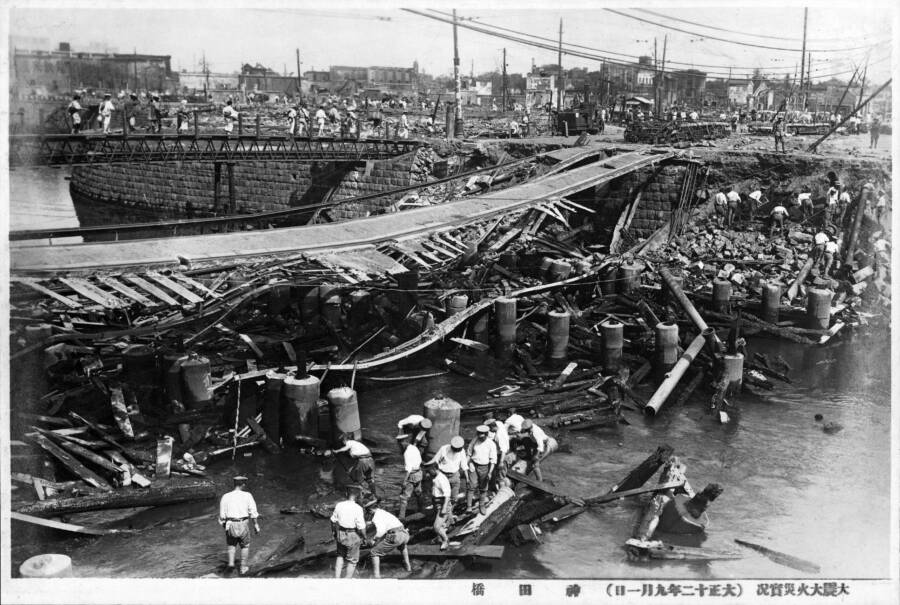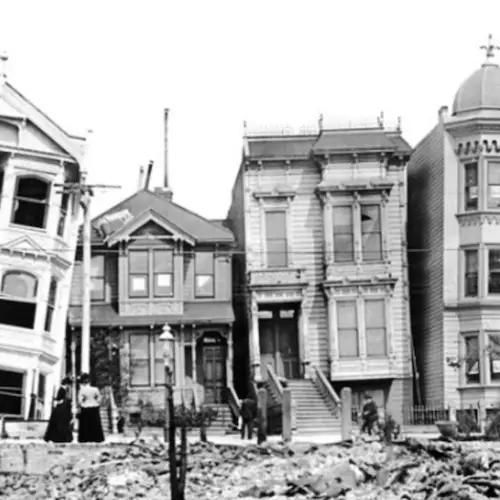On September 1, 1923, Japan was struck by the Great Kantō Earthquake, which triggered a series of disasters including firestorms, tsunamis, and landslides that left more than 100,000 dead and 40,000 missing.

Public DomainAn illustration of the destruction following the Great Kantō Earthquake of 1923 by artist Takehisa Yumeji.
Japan is no stranger to earthquakes, but few in the country’s long history have been quite as devastating as the Great Kantō Earthquake of 1923.
The 7.9-magnitude quake destroyed more than half of the brick buildings in the Tokyo-Yokohama metropolitan area and caused roughly one-tenth of the reinforced concrete structures in the region to collapse.
Thousands of houses were destroyed, either from the earthquake itself or the ensuing fires that spread amid the chaos. Making matters worse, the quake created a 39.5-foot-tall tsunami that struck Atami on the Sagami Gulf, destroying another 155 houses and killing 60 people.
In total, some estimates suggest that the Great Kantō Earthquake and its aftereffects killed more than 100,000 people, with tens of thousands more missing, making it the worst natural disaster ever to befall the people of Japan.
The Day Of The Great Kantō Earthquake
It began not long before noon on September 1, 1923. Six miles below the seafloor of Sagami Bay, 30 miles south of Tokyo, a 60-by-60-mile segment of the Philippine oceanic plate ruptured and crashed into the Eurasian continental plate. The shock was felt immediately; the consequences would last for years.
A crowd had gathered on the docks of Yokohama, Japan's biggest port, to wave goodbye to the passengers of the Empress of Australia, a luxury steamship bound for Vancouver.
Ellis M. Zacharias, a U.S. Naval officer, recalled, "The smiles vanished, and for an appreciable instant everyone stood transfixed" as "the sound of unearthly thunder" enveloped them. Then, the pier collapsed beneath his feet, and people and cars plunged into the water.
Minutes later, a 39.5-foot-high wave of water crashed down and swept thousands of people away.
Fires broke out across the city, easily torching the wooden houses that dotted the landscape of Yokohama, the "City of Silk," and Tokyo, the nation's capital.
Yokohama had once been a beacon of Japanese optimism.
The first "Foreign Settlement" in the country, Yokohama was founded in 1859 after U.S. Commodore Matthew Perry forced the shogun to open Japan to the Western world. The city had grown to have a population of nearly half a million.
It was a cultural hub where folk from all walks of life gathered to trade ideas and sell their wares. Japanese writer Junicho Tanizaki described Yokohama as "a riot of loud Western colors and smells—the odor of cigars, the aroma of chocolate, the fragrance of flowers, the scent of perfume."
Vast stretches of the entire city were destroyed in about 14 seconds.

Chronicle/Alamy Stock PhotoAn artist's depiction of the initial destruction caused by the Great Kantō Earthquake.
The mostly wooden buildings pancaked to the unstable, watery ground. Hundreds of people died under the weight of the debris. But this was just the beginning of the destruction, as the quake's shockwaves spread throughout the Kantō region, wreaking havoc as they made their way toward Tokyo.
High winds spread the flames across the countryside, where they continued to tear through homes. Those in poorer neighborhoods on the east side of the Sumida River watched in stunned horror as their communities literally crumbled before their eyes in seconds. Some of them fled toward the river — then were drowned when the bridge collapsed.
Tens of thousands gathered in an empty patch of ground near the river, but their temporary refuge was destroyed when a 300-foot-tall "fire tornado" surrounded them. Around 44,000 people in all had gathered here. Only 300 survived.
It would take 48 hours before the flames died down. When they did, the extent of the destruction slowly became apparent: 45 percent of Tokyo had burned, and an unspeakable number of people died.
And though the terrifying event had ended, the long road of reconstruction was just beginning.
Rebuilding Japan In The Wake Of The Yokohama-Tokyo Earthquake
The cities weren't the only thing to fall apart during the quake. Public order and calm gave way to chaos and panic. According to the Association for Asian Studies, refugees of the disaster quickly began to spread rumors. Some said Mt. Fuji had erupted or soon would. Others claimed that Yokohama had been completely washed away.
Some of these rumors directly targeted Koreans, the largest ethnic minority in Japan. They said the Koreans had formed lawless bands and set fires, looted collapsed buildings, and poisoned wells throughout the region.
Ad-hoc groups of vigilantes self-appointed to address the fictitious problem roamed the region, exacting their justice where they deemed fit. Estimates suggest that around 6,000 and as many as 10,000 Koreans were killed due to the violence brought about by these rumors.
At first, news of these mass killings was kept under wraps, but in the months following, various newspapers published harsh, deserved critiques of the massacres. Tawara Magoichi, a politician, said the "deplorable" slaughter exposed "a major defect in the national spirit" of the Japanese people.
It took 50,000 troops from the Imperial Japanese Army to restore order to the region. They implemented stabilization, recovery, and relief operations, which included distributing food and water, constructing 74 temporary bridges, clearing 130 miles of roads, and collecting and burning corpses.
Rather than the sprawling city it had once been, Tokyo had, by the end of 1923, become "a city of barracks, temporary shelters, and makeshift communities."
With Tokyo all but destroyed, the earthquake also presented the perfect opportunity not just to rebuild the city, but to reshape it as well.
And while Tokyo would indeed become a truly modern metropolis following its reconstruction, the quake's effects were felt far and wide — especially as right-wing groups sought to use it to their advantage.
How The Great Kantō Earthquake Changed Japan
Japanese elites began to utilize the calamity to fulfill various political agendas. Many in power, including politicians, religious leaders, and journalists, took the opportunity to reinforce their previously held disdain for the modern state of Japan.
They saw the country as too decadent, selfish, frivolous, and individualistic. They described the quake and the ensuing chaos as divine punishment for the country's so-called moral decline.
They sought to restore Japan to its Meiji-era "glory," when society focused on virtues like loyalty, sacrifice, frugality, and obedience.

Chronicle of World History / Alamy Stock PhotoVigilantes fighting after the Great Kantō Earthquake of 1923.
The Great Kantō Earthquake struck at a time when liberalism and left-wing ideas began to take hold of the average Japanese citizen, which those in power greatly opposed.
The disaster seemed to precipitate the rise of fascism in the country and the ensuing involvement in World War II. However, there is still some debate as to whether it was, in fact, the earthquake that sparked these sentiments rather than merely revealing them.
However, even as the political temperature seemed to warp around the tragedy, within it was the seed of the new Tokyo.

Initial plans for the reconstruction were grand, envisioning a fundamental rebirth from the blank slate left by the disaster. However, conflicting desires and political bickering dragged on the project, and the budget fell below even many conservative estimates.
But even as the scope of the rebuild shrank, it still heralded a glimpse of the nation's future. It would take decades for the city and region to recover, aided in no way by the destruction wrought during World War II. At the other end, though, was a vibrant and vital city.
Given its drastic impact, it's impossible not to wonder how Japan would have evolved had the quake not happened; there are, of course, no real answers to the question. But in Japan's long history, the Great Kantō Earthquake marks a distinct and important turning point, and the repercussions were felt for decades, both at the site of the tragedy and around the world.
After learning about the Great Kantō Earthquake of 1923, read about another devastating earthquake — one that struck San Francisco in 1906. Or, see this gallery of 33 photos that reveal the true horrors of the Lebanese Civil War.
